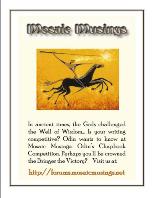  |
 Mar 27 06, 21:24 Mar 27 06, 21:24
Post
#1
|
|
|
Group: Gold Member Posts: 3,822 Joined: 3-August 03 From: Florida Member No.: 10 Real Name: Elizabeth Writer of: Poetry Referred By:Lori Kanter |
INTRODUCTION TO SYMBOLISM
This Introduction to Symbolism is provided with permission by its author, Howard Miller, who has presented us with an easy to understand explanation and educational break down to help us understand symbolism and to use symbolism at its height of potential. I recommend this to EVERYONE. A MUST READ! Introduction to Symbolism Part I Symbolism is one of the most powerful tools the writer has available because of its ability to communicate a great deal concisely and compactly while at the same time involving the reader in the work. Understanding symbolism—what it is, how it functions, and what kinds of meaning it can communicate—requires a certain amount of effort because it doesn’t function in quite the same manner as any other literary device and in some ways is more complex than any other literary device; as a result, there are frequent misconceptions about symbolism and symbols. Hopefully, this discussion will provide a useful introduction to symbolism in poetry. Most standard definitions of “symbol” are similar to this: “a symbol is something that means more than it is or that stands for something other than itself.” While that’s absolutely correct, it also frankly isn’t really all that helpful. We will attempt to explore the nature of symbolism in enough detail that this definition will begin to make sense. One place to begin is to look at what a symbol isn’t. Most importantly (because symbols are often confused with metaphors), a symbol isn’t a metaphor (although, to complicate matters, a metaphor can be a symbol—but we’ll get to that a bit later). Here are three reasons why not: 1. A metaphor is by definition a non-literal statement; in other words, what a metaphor says isn’t literally true. When Keats says: “Then felt I like some watcher of the skies When a new planet swims into his ken . . . ,” we know that he doesn’t mean for us to see the planet as an actual fish or aquatic mammal that’s really swimming along with fins or flippers; we are not intended to take the statement as literally true. However, that is not the case with a symbol: a symbol actually and literally is exactly what the writer says it is; it just happens to be something else in addition. 2. A metaphor operates on the basis of similarity; there is some necessary way in which what is used as a metaphor (the vehicle) resembles that to which it refers (the tenor). Thus, in the Keats’ example, it is the motion of the planet—a steady, regular motion—that resembles the motion of something that is swimming. Again, with a symbol, there is no necessary point of similarity between that which is used as a symbol and that which it represents. 3. The meaning of a metaphor is based on the similarity between vehicle and tenor, and the meaning can be determined by identifying the similarity (or similarities) between the two. However, since there is no essential similarity between a symbol and what it represents, the meaning of the symbol cannot necessarily be derived by identifying some similarity between the two. Among other things, this means that, unlike with a metaphor, the meaning of a symbol is not necessarily readily or easily apparent, nor can it even always be determined that something which is functioning as a symbol is functioning as such upon first encountering it. As a consequence of these points, a symbol is qualitatively different from a metaphor and functions in a completely different way. Now that we’ve seen what a symbol isn’t, let’s look at what a symbol is. A symbol is something that simultaneously possesses two different types of meaning. The first type of meaning a symbol possesses is “literal meaning.” That which functions as a symbol is, to begin with, always an image, always something specific, definite, concrete, and directly apprehensible by the senses. Anything that fits this category may function as a symbol: an object (either animate or inanimate), a place, a person, an event, an action, even a metaphor. What is important to remember is that what is used as a symbol is actually there; if the poet chooses to use a rock or a weevil as a symbol, then that rock or that weevil is actually there in the scene being described (unlike the fish/aquatic mammal of Keats’ metaphor), and the poet is talking about an actual rock or weevil. It’s just that what he says about the rock/weevil causes it to come to stand for or to represent something else at the same time. The second type of meaning is that “representational meaning.” Because of the way the poet handles the literal object/etc., it comes to stand for or to represent something else. What it stands for is always abstract: thoughts, feelings, ideas, beliefs, etc. Further, what it stands for is not a single abstract or generalized quality but a whole class of closely-related qualities, all of which are being evoked through the symbol. It is this attribute—the ability to evoke a whole series of “meanings”—that gives the symbol its depth and power. Let’s look at a simple example that uses a familiar cultural symbol—a symbol in common use that most of us are familiar with. If you take a rectangular piece of white cloth and paint a smaller blue rectangle in the upper left corner with 50 white stars, then paint 7 red and 6 white stripes over the rest of the piece of cloth, what do you end up with? Literally, you have a piece of painted cloth. However, because of the way that particular pattern of painted cloth has been used over the past 200+ years, a whole series of things have come to be associated with it that it is said to “stand for” or to represent; some of these would include (these are actual answers from my past students): freedom, democracy, patriotism, strength, justice, honor, truth, sacrifice, courage, opposition to tyranny. (Obviously, to those who aren’t U. S. citizens, there may well be an entirely different set of abstractions it represents.) Now, it isn’t that that piece of painted cloth stands for any one of those qualities—it stands for ALL of them, and others that one could come up with as well. That is what a symbol represents: a whole class of related abstract qualities. In using the literal object (the piece of painted cloth), one is evoking that entire class of qualities. That leads directly into another important attribute of a symbol: it may well have different significances ("meanings") for different individuals. Exactly what significance it will have for any one individual depends upon that individual's personal experiences, background, etc.; since different individuals have different backgrounds and experiences, the symbol may have different specific meanings for each, because each brings something different to the viewing and reaction to the symbol. But ultimately the true meaning of the symbol is the composite class, not just one specific "meaning"; the symbol is not exhausted of meaning by assigning one specific association to it. It is in this sense (so frequently misunderstand) that a symbol--or a poem employing a symbol--may be said to have different meanings for different individuals. However, one who genuinely understands symbolism knows not to stop with assigning one specific meaning to a symbol but to look for the underlying pattern of meanings which embraces the class as a whole. It is that which gives the symbol its real power. Obviously, there is no similarity between the literal object--a piece of painted cloth-- and what it represents--those qualities U. S. citizens associate with their country--, nor can one deduce what the object represents upon encountering it for the first time. Rather, one would have to see it used over a period of time to begin to form a clear idea of what the class of abstractions is it represents. The same is often true with a literary symbol, as well. So what does all this mean for the use of symbolism in poetry? In Part II, we'll begin to see through an examination of a clearly symbolic poem, Frost's "The Road Not Taken." _ ·······  ······· ·······Nominate a poem for the InterBoard Poetry Competition by taking into careful consideration those poems you feel would best represent Mosaic Musings. For details, click into the IBPC nomination forum. Did that poem just captivate you? Nominate it for the Faery award today! If perfection of form allured your muse, propose the Crown Jewels award. For more details, click here!
MM Award Winner   |
|
|
|
1 User(s) are reading this topic (1 Guests and 0 Anonymous Users)
0 Members:
  |

|
Lo-Fi Version | Time is now: 16th April 2024 - 18:41 |

















